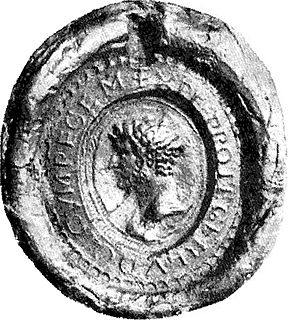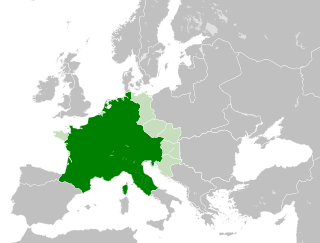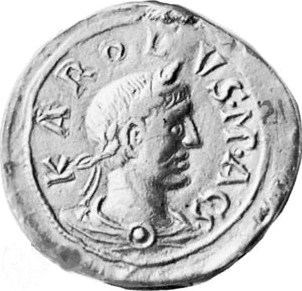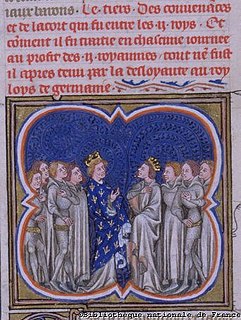
Arnulf of Carinthia was the duke of Carinthia who overthrew his uncle, Emperor Charles the Fat, became the Carolingian king of East Francia from 887, the disputed King of Italy from 894 and the disputed Holy Roman Emperor from February 22, 896 until his death at Regensburg, Bavaria.
The 860s decade ran from January 1, 860, to December 31, 869.

Louis the German, also known as Louis II, was the first king of East Francia, and ruled from 843–876 AD. Grandson of emperor Charlemagne and the third son of Louis the Pious, emperor of Francia, and his first wife, Ermengarde of Hesbaye, he received the appellation Germanicus shortly after his death in recognition of Magna Germania of the Roman Empire, reflecting the Carolingian's assertions that they were the rightful descendants of the Roman Empire.

The Carolingian Empire (800–888) was a large Frankish-dominated empire in western and central Europe during the early Middle Ages. It was ruled by the Carolingian dynasty, which had ruled as kings of the Franks since 751 and as kings of the Lombards in Italy from 774. In 800, the Frankish king Charlemagne was crowned emperor in Rome by Pope Leo III in an effort to revive the Roman Empire in the west. The Carolingian Empire is considered the first phase in the history of the Holy Roman Empire, which lasted until 1806.

Carloman was a Frankish king of the Carolingian dynasty. He was the eldest son of Louis the German, king of East Francia, and Hemma, daughter of a Bavarian count. His father appointed him margrave of Pannonia in 856, and upon his father's death in 876 he became King of Bavaria. He was appointed by King Louis II of Italy as his successor, but the Kingdom of Italy was taken by his uncle Charles the Bald in 875. Carloman only conquered it in 877. In 879 he was incapacitated, perhaps by a stroke, and abdicated his domains in favour of his younger brothers: Bavaria to Louis the Younger and Italy to Charles the Fat.

Charles III, also known as Charles the Fat, was the emperor of the Carolingian Empire from 881 to 888. A member of the Carolingian dynasty, Charles was the youngest son of Louis the German and Hemma, and a great-grandson of Charlemagne. He was the last Carolingian emperor of legitimate birth and the last to rule over all the realms of the Franks.

Zwentibold, a member of the Carolingian dynasty, was the illegitimate son of Emperor Arnulf. In 895, his father, then king of East Francia, granted him the Kingdom of Lotharingia, which he ruled until his death. After his death he was declared a saint and martyr by the Catholic Church.

Svatopluk I or Svätopluk I, also known as Svatopluk the Great, was a ruler of Great Moravia, which attained its maximum territorial expansion during his reign.
Rastislav or Rostislav, also known as St. Rastislav, was the second known ruler of Moravia (846–870). Although he started his reign as vassal to Louis the German, king of East Francia, he consolidated his rule to the extent that after 855 he was able to repel a series of Frankish attacks. Upon his initiative two brothers, Cyril and Methodius sent by the Byzantine Emperor Michael III in 863, translated the most important Christian liturgical books into Slavonic in his realm. Rastislav was dethroned by his nephew Svatopluk I of Moravia who handed him over to the Franks.

Pribina was a Slavic prince whose adventurous career, recorded in the Conversion of the Bavarians and the Carantanians, illustrates the political volatility of the Franco–Slavic frontiers of his time. Pribina was the first ruler of Slavic origin to build a Christian church on Slavic territory in Nitra, and also the first to accept baptism.
Slavomir was a duke of Moravia (871). He led a revolt against the Franks who had annexed Moravia during the incarceration of his relative, Svatopluk I.
Hugh or Hugo was an illegitimate son of Lothair II, king of Lotharingia, by his concubine Waldrada. His father made him Duke of Alsace in 867.

The March of Carinthia was a frontier district (march) of the Carolingian Empire created in 889. Before it was a march, it had been a principality or duchy ruled by native-born Slavic princes at first independently and then under Bavarian and subsequently Frankish suzerainty. The realm was divided into counties which, after the succession of the Carinthian duke to the East Frankish throne, were united in the hands of a single authority as a march of defence against the Slavs of Pannonian Croatia. When the march of Carinthia was raised into a Duchy in 976, a new Carinthian march was created. It became the later March of Styria.

The Eastern March or March of Pannonia was a frontier march of the Carolingian Empire, named after the former Roman province of Pannonia. It was erected in the mid-ninth century in the lands of the former Avar Khaganate against the threat of Great Moravia and lasted only as long as the strength of that state. It was referred to in some documents as terminum regni Baioariorum in Oriente or "the end of the kingdom of the Bavarians in the east" and from this is sometimes called the "(Bavarian) eastern march," a term more commonly used to refer to the later Margraviate of Austria, established in 976 as a sort of late successor state. The East Frankish rulers appointed margraves (prefects) to govern the March.
Thacholf, Thachulf, Thaculf, or Thakulf was the Duke of Thuringia from 849 until his death. He held the titles of comes (count) and dux (duke) and he ruled over a marca (march). He may have been the son of Hadulf, son of Thankulf.
Saint Arn or Arno von Endsee was the Bishop of Würzburg from 855 until his death. He was a pupil of Bishop Gozbald, who died on 20 September 855; Arn was elected bishop in his place. Arn was a warrior-prelate, recorded fighting against almost every external foe of the Germans at one point in his career or another.
Theotgaud was the archbishop of Trier from 850 until his deposition in 867. He was the abbot of Mettlach prior to his election in 847 to succeed his uncle, Hetto, as archbishop. He took up his post three years later, but was inadequately trained in theology and politically and administratively inept.

Louis the Younger, sometimes Louis III, was the second eldest of the three sons of Louis the German and Emma. He succeeded his father as the King of Saxony on 28 August 876 and his elder brother Carloman as King of Bavaria from 880 to 882. He died in 882 and was succeeded in all his territories, which encompassed most of East Francia, by his younger brother, Charles the Fat, already king of Italy and emperor.
Radbod was the East Frankish prefect of the Eastern March, the Bavarian frontier towards the Slavs, appointed in 833. He had been appointed the office after Louis the German's conquest in 828, and subsequent Christianization of the Moravians (828–33). In 833, according to the Conversio Bagoariorum et Carantanorum, a Slavic prince, Pribina, had been "driven across the Danube by Mojmir, duke of the Moravians", and fled to Radbod in East Francia around 833. Radbod introduced him to King Louis the German, who ordered that Pribina should be "instructed in the faith and baptized", and that he serve with his followers in Radbod's army. Before long, however, Radbod and Pribina fell out, and the latter, fearing for his life, fled with his son Koceľ to the First Bulgarian Empire, and then to Lower Pannonia ruled by a Slavic duke, Ratimir. Since Lower Pannonia was part of Radbod's prefecture, Ratimir's harboring of Pribina was tantamount to rebellion, therefore, in 838, Louis the German sent Radbod at the head of a large Bavarian army to crush Ratimir, but Pribina and his followers took refuge with the count of Carniola, Salacho. In short time the latter brokered a reconciliation between Radbod and Pribina, and Louis solved the ongoing instability by appointing Pribina as his faithful dux with lands in around the Zala river. Radbod held contacts with Rastislav, ruler of the Moravians, who had long posed a danger to Bavaria. According to the Annals of St-Bertin, in 853 Charles the Bald, king of West Francia, bribed the Bulgarians to ally with the Slavs and together attack Louis the German's kingdom. In the course of the Bulgarian–Moravian attack, Louis the German deposed Radbod in 854 for infidelity, after an uprising. Radbod then formed a rebel alliance with Rastislav. In 855, Rastislav (Rastiz) rebelled, and Carloman was made prefect in Radbod's place in 856. Carloman's 858 campaign forced Rastislav to make peace.